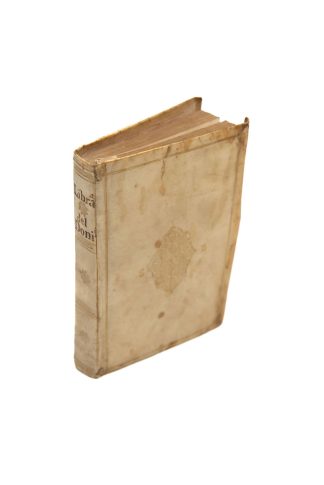DONI, Anton Francesco.
CHARMING CONTEMPORARY BINDING
La libraria del Doni Fiorentino.
Venice, Gabriel Giolito, 1558.£6,950.00
FIRST EDITION thus. 8vo. pp. [1]-296. Roman letter, with Italic. Woodcut printer’s device to title, 6 full-page woodcut portraits of Dante, Petrarch, Boccaccio, Ariosto, Domenichi and Bembo, decorated initials and ornaments. Light yellowing in places, title a little soiled at fore-edge, very faint minor water stain along blank gutter, small oil stain to outer margin of first 3 and last 2 gatherings, handful of ll. slightly browned. A very good copy in handsome (Swiss?) contemporary limp vellum, yapp edges, single gilt ruled, gilt arabesque flanked by gilt initials SB to centre of covers, small gilt fleurons to corners, flat spine, compartments divided by gilt rolls of tendrils, small gilt fleuron to each, early ms title inked to spine, a.e.g. Minor loss to 1 gilt fleuron, the odd spot to covers, c.1700 ms ‘Di Antonio Orsetti’ (a trifle smudged) to ffep and ‘Cansone del Caro’ to rear ep, soiled fly.
The splendid binding, the first owner of which remains unidentified, is a lovely example of the centrepiece fashion popular in Italy and France, in the second half of the C16. Its construction contains both Italian and French elements. It is likely that the binding was produced in Switzerland, where different traditions met. In the second half of the C16, gilt angular lozenge-shaped centrepieces were frequently employed by the influential ‘King’s Binder’ in Geneva (e.g., BL C46h3, Davis594 and the more elaborate Davis593).
A good copy of the first complete edition of the first, illustrated, bibliography of Italian literature, in print and ms. This is the first to unite both parts, originally published in 1550 and 1551. Anton Francesco Doni (1513-74) was a writer and translator who travelled widely in northern and central Italy, before settling in Venice. He was also an occasional printer and was involved with scholars of heterodox leanings, like Aretino. Indeed, he probably sponsored the production of the second edition in Italian of Agrippa’s ‘De incertitudine’ (1549). His most important work, ‘Libraria’ gathers together, though not in fully systematic fashion, all major works by Italian authors; unlike his predecessors, Trithemius and Gesner, he also included those in the vernacular, as well as music. Part I focuses on over 100 vernacular authors, in alphabetical order; each entry comprises a brief summary of the subjects, followed by the respective titles. Beside the likes of Ariosto, Vittoria Colonna and Castiglione are dozens of lesser known or obscure authors. There follow translations from the Greek or other European languages, two sections organised by genre (rime, tragedie, medicina, etc.), one listing all vernacular books, one on ‘libri di ricami’ (pattern books), and one on printed music (madrigali, mottetti, messe). The most unusual Part II focuses on ‘autori veduti a penna’ (seen in ms form), not yet in print, e.g., from the obscure Africo di Mensola’s ‘Rasoio del Burchiello’ to unpublished poems by Annibal Caro (who caught the eye of an early annotator of this copy). Part III lists all major literary academies in Italy.
Several books are extant bearing the c.1700 inscription ‘Di Antonio Orsetti’. He was probably a member of the wealthy Tuscan family from Lucca.
Columbia, Chicago and UCLA copies recorded in the US. USTC 827625; EDIT16 CNCE 17702; Brunet II, 814 (mentioned); Bongi, Annali dei Giolito, II, p.38 (1557 ed.). Raccolta vinciana, 25 (1993), p.345.In stock








